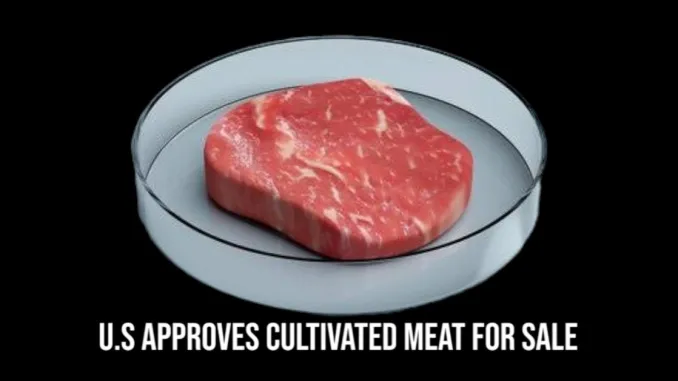
US Department of Agriculture Clears Sale of Cultivated Meat
HIGHLIGHTS:
- USDA Approval for Cultivated Chicken Sales: GOOD Meat, a division of Eat Just, Inc., has received USDA approval for the sale of its cultivated chicken in the United States.
- UPSIDE Food’s Cultivated Chicken: UPSIDE Food, another company, has received USDA approval for its textured chicken product grown from over 99% chicken cells.
- Environmental and Sustainability Benefits: Cultivated meat proponents highlight its sustainability, as it does not require antibiotics and reduces methane emissions associated with animal agriculture, particularly beef cattle.
- Chefs and Restaurants Promoting Cultivated Meat: Both GOOD Meat and UPSIDE Food have partnered with renowned chefs to serve cultivated chicken in their restaurants.
- The Process of Cultivated Meat Production: Cultivated meat is produced by extracting cells from animals through a needle biopsy.
For centuries, consuming meat meant slaughtering animals, but a groundbreaking advancement in the field of cultivated meat is changing that paradigm.
Scientists have developed a method to produce meat by growing cells extracted from animals. It eliminates the need for traditional animal slaughter.
The US Department of Agriculture (USDA) has granted its first approvals for the sale of the meat. That is, meat produced through this innovative process.
GOOD Meat, a division of Eat Just, Inc., has announced that its cultivated chicken, grown directly from animal cells. The firm has received USDA approval for sale in the United States.
This marks a significant moment for the company, the industry, and the entire food system. This is according to Josh Tetrick, co-founder and CEO of GOOD Meat and Eat Just.
GOOD Meat has already been selling cultivated chicken in Singapore since 2020. This was when the country became the first to allow commercial sales of such meat.
The USDA has also cleared UPSIDE Food’s cultivated chicken, another company that produces chicken directly from animal cells.
UPSIDE Food’s textured chicken product closely resembles chicken breast in taste and texture, made from over 99% chicken cells.
During a taste test, the cultivated chicken cooked in a white-wine butter sauce was described as delicious and remarkably similar to traditional chicken breast.
The company’s facility in Emeryville, Calif., utilizes large stainless steel tanks resembling a brewery for meat growth and production.
Initially, UPSIDE Food’s facility can produce about 50,000 pounds of meat per year. This is with plans to expand beyond chicken once this product is launched.
Last fall, the US Food and Drug Administration (FDA) declared UPSIDE’s cultivated chicken safe for consumption. Last week, the USDA approved the company’s label and now, with the grant of inspection.
UPSIDE Food has overcome the final regulatory hurdle to commence sales.
Bruce Friedrich, president of the Good Food Institute, a non-profit organization tracking investment trends in alternative proteins, describes this moment as a pivotal one in food and agriculture.
It brings consumers one step closer to enjoying the taste of meat they love. This in turn avoids animal slaughter and the environmental impact associated with traditional animal food production.
Over 150 companies dedicated to producing cultivated meat and seafood have raised more than $2.8 billion in investments.
UPSIDE Food’s strategy is to raise awareness about cultivated meat as a means of promoting a more humane and sustainable food system.
The company recognizes that taste is crucial, leading to partnerships with renowned chefs.
Dominique Crenn, owner of the three-Michelin-starred restaurant Atelier Crenn, will serve UPSIDE’s cultivated chicken at her restaurant Bar Crenn in San Francisco.
GOOD Meat has partnered with celebrity chef Jose Andres, who plans to serve their cultivated chicken in one of his restaurants.
Cultivated meat proponents highlight its sustainability and the ability to produce it without antibiotics. Also, without the methane emissions associated with animal agriculture, particularly beef cattle.
The conventional methods of meat production in concentrated animal feeding operations pose a risk of disease emergence, according to scientists.
Animal agriculture is a significant contributor to human-induced greenhouse gas emissions. So, addressing this issue is crucial for mitigating climate change.
While cultivated meat’s potential to reduce emissions depends on the energy sources powering its facilities, it offers a promising avenue for change.
The process of producing cultivated meat involves extracting cells from animals using a needle biopsy.
However, scientists no longer need to extract cells from animals repeatedly, as a cell bank stores an abundant supply. Companies can select the desired cells for growth.
Inside the stainless steel tanks, the cells are fed a nutrient mix similar to what an animal would consume—comprising fats, sugar, amino acids, and vitamins—which enables cell proliferation and the development of meat.
Cultivated meat, also known as cell-based or lab-grown meat, has been gaining traction as a sustainable and ethical alternative to traditional animal agriculture.
Here are some additional related findings:
- Environmental Benefits: Cultivated meat has the potential to significantly reduce the environmental impact associated with conventional meat production.
Studies have shown that it requires less land, water, and energy compared to raising and processing livestock. It can also help mitigate deforestation, water pollution, and greenhouse gas emissions.
2. Food Security: As the global population continues to grow, the demand for meat is expected to increase.
Cultivated meat offers a promising solution to meet the rising demand without further straining natural resources or compromising food security.
It can provide a stable and sustainable protein source, particularly in regions where traditional meat production is challenging.
- Animal Welfare: One of the primary motivations behind cultivated meat is to address animal welfare concerns. By eliminating the need for animal slaughter, it offers a cruelty-free alternative. This aligns with the growing ethical considerations of consumers.
Cultivated meat production aims to provide meat products while minimizing harm to animals.
- Nutritional Control: Cultivated meat offers the potential for precise nutritional control.
Scientists can optimize the nutrient composition of the growth medium, ensuring that the cultivated meat is nutritionally balanced and free from undesirable additives or contaminants.
This level of control opens up possibilities for tailored meat products with specific health benefits.
- Future Expansion: While the initial focus has been on poultry and beef, the cultivation of other meat types, such as pork, seafood, and exotic meats, is also being explored.
Scientists are continually improving the cultivation process and scaling up production to make cultivated meat more accessible and affordable for consumers.
6. Regulatory Frameworks: Governments and regulatory bodies around the world are actively working on establishing clear guidelines and regulations for cultivated meat.
The recent approvals from the USDA signal a positive step forward in the acceptance and commercialization of this innovative food technology. Regulatory frameworks will ensure safety, quality and labeling standards for cultivated meat products.
- Consumer Acceptance: Consumer acceptance and perception play a crucial role in the success of cultivated meat.
Surveys and studies indicate a growing openness among consumers to try and adopt alternative meat options, including cultivated meat.
Factors such as taste, price, familiarity, and effective communication about the benefits of cultivated meat will influence consumer adoption rates.
As research and development in the field of cultivated meat continue to progress, it holds the potential to revolutionize the way we produce and consume meat, offering a sustainable and ethical choice for the future of food.
Please Share: US Department of Agriculture Clears Sale of Cultivated Meat















